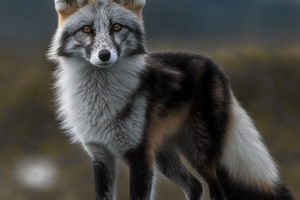An ice age is the period when the earth’s temperature drops significantly, with the result that ice caps and glaciers expand from the polar poles and spread over the earth.
Since the earth was formed approximately 4.5 billion years ago, there have been no less than five great ice ages.
Each of these ice ages lasted for many millions of years, and scientists estimate that for about a quarter of the time that has passed since the formation of the Earth, an ice age raged.
The last great ice age started 2.6 million years ago and it is still not over. In other words, we are still living in an ice age.
In the periods between the great ice ages, the earth was completely free of ice, and we know that this is not the case today, as about a tenth of the land is now covered in ice.
The Great Ice Ages include periods of smaller ice ages, also called glacial periods, which can last for thousands of years. Following them, there will be warmer periods, warm periods characterized by the retreat of glaciers.
The five great ice ages
Since the earth was formed approximately 4.5 billion years ago, there have been no less than five great ice ages.
Huron: F 2.4-2.1 billion years ago
Cryogen: 850-635 million years ago
Andes-Sahara: F 460-430 million years ago
Karoo: 360-260 million years ago
Quaternary: F 2.6 million years ago, to our time
The last little ice age ended 11,500 years ago and was followed by a warmer warm period that we are currently in. This period is also called the Holocene period.
The last ice age went by the name “weichsel” and it reached its peak almost 22,000 years ago. At that time, all of the Nordic countries were covered with glaciers, with the exception of a small corner of Denmark. The same was true for the northern part of Russia, Greenland and a large part of North America.
When the glaciers retreated due to rising temperatures, the sea level rose due to all the meltwater and the landscape took on the appearance we know today.
However, the warming climate also brought disadvantages. When the ice age ended, about a third of all the largest mammals on Earth had died out, including the saber-toothed tiger and the woolly elephant.
Cool summers increase the amount of ice
The beginning and end of ice ages are marked by the Earth’s orbit around the Sun, which changes between being elliptical and almost circular, as well as being affected by slight changes in the tilt of the Earth’s moon.
The fluctuations affect how much solar radiation reaches the earth’s surface at the various latitudes and thus also how cold or hot it is.
This period is called the Milankovitch period after the Yugoslav geophysicist Milutin Milankovitch, who first described the phenomenon in the 1940s.
Milankovitch said solar radiation to the poles mainly depends on three factors, each of which fluctuates regularly but independently of each other.
The factors are the Earth’s tilt (40,000 year oscillation), the Earth’s orbit (20,000 year oscillation) and the shape of the Earth’s orbit (100,000 year oscillation).
The fluctuations result in unique complex changes in the amount of energy that hits the earth in different seasons and places. It is these changes that pave the way for massive temperature drops that cause ice ages.
Climatologists agree that the transition to an ice age occurs during periods when very little solar energy reaches the summer in the belt around 65 degrees latitude.
If the snow does not melt in summer, the earth absorbs less sunlight. The rest is reflected back into space by the snow-white surface. This intensifies the cooling initiated by fluctuations in the Earth’s orbit around the Sun.
This is how ice ages form
The Earth’s orbit changes in fixed cycles every 100,000, 40,000 and 20,000 years. During these periods there will be different levels of solar radiation and ideal conditions will be created for an ice age.
When will the next ice age be?
Warm periods, like the one we are currently in, usually last for 10,000 to 30,000 years. When they end, the Earth falls back into the freezer of a new ice age that lasts 90,000 to 100,000 years.
Since the last ice age ended only 11,500 years ago, a new ice age may be on the horizon. In theory, at least.
However, scientists answer that we do not need to fear that a prolonged winter is near. The man-made global warming has caused such a large increase in temperature that the ice age has a harder time gaining a foothold on the earth.
If the “UN Intergovernmental Panel on Climate Change” is anything to go by, at least 30,000 years will pass before the next cold period makes itself felt in the Northern Hemisphere.
Prehistoric climatologist Michael Sandstrom at Columbia University in New York has studied the amount of carbon dioxide in the air during warm periods and ice ages, and he believes that a new ice age is not expected in the near future.
“We’re pumping so much carbon dioxide into the atmosphere that another ice age probably won’t happen for another 100,000 years,” he told Live Science in 2017.
The Little Ice Age paralyzed Europe
A large part of the world, and not least Europe, was afflicted by an enormous bitter cold from 1450 to 1850. This period is known today as the “Little Ice Age”.
The average temperature was about 1.5 degrees lower than it is today, and the period was the coldest period since the last “real” ice age raged approx. 11,500 years ago.
The coldest years of the “Little Ice Age” were between 1645 and 1715, when icy cold air hit the western part of Europe so millions froze, starved and died.
Birds turned into icicles and fell from the sky. The grain harvest across Europe failed and there was a massive famine. Harbors, rivers and lakes froze.
The English were particularly badly hit in the winter of 1683-84, which is the harshest winter in the nation’s history.
The River Thames was frozen over for two whole months and the ice was up to 28 centimeters thick.
There were many reasons for these harsh winters in Western Europe during the “Little Ice Age”.
Several scientists have pointed out, among other things, the high level of volcanic activity during the period, which contributed to the increased cold.
Large volcanic eruptions send millions of cubic meters of ash and sulfur dioxide into the atmosphere, blocking out the sun even for years.
Other scientists point to less solar activity during the season as the main cause of the increased cold.
In 2018, British researchers from University College London and the University of Leeds presented another explanation for the beginning of the “Little Ice Age”: the extinction of Native Americans.
Before Europeans invaded America, there were approx. 60 million people in the country. Between 1492 and 1600, 90 percent of all natives died from war and disease.
The extinction left millions of hectares of abandoned agricultural land, which later became forests. The new trees sucked so much CO2 out of the atmosphere that the temperature dropped by 0.15 degrees, according to their study .












